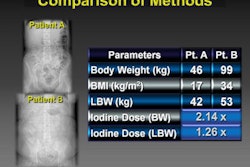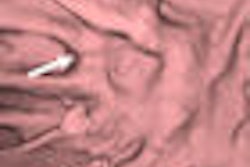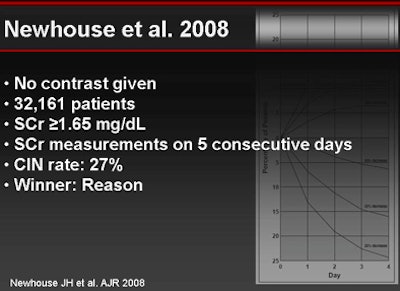
Despite the recent controversy over contrast media and contrast-induced nephropathy (CIN), a review of clinical studies indicates a distinct lack of serious adverse events resulting from CIN.
To be sure, postprocedural tests of serum creatinine and glomerular filtration rates have shown a certain percentage of patients meeting the definition of contrast-induced nephropathy. But the patients don't appear to be suffering for it.
At Stanford University's International Symposium on Multidetector-Row CT, Dr. U. Joseph Schoepf looked at the evidence of harm from CIN and found it lacking.
"Although intravenous contrast media administration is frequently associated with an increase in serum creatinine that fulfills the definition of CIN, clinically manifest adverse outcomes are extremely rare," said Schoepf, an associate professor of radiology and cardiology at the Medical University of South Carolina (MUSC) at Charleston.
CIN is invariably used as a primary end point to look at the effects of contrast material on at-risk patients, such as those with renal function and/or diabetes. It is defined as a laboratory parameter, i.e., an absolute (≥ 0.5mg/dL) or relative (≥ 25%) increase in serum creatinine (SCr) over baseline.
"As we know, lab parameters are not everything," Schoepf said. "I think what counts in terms of patient safety -- and to assess the effects of contrast media -- is hard patient outcomes associated with the administration of contrast, such as acute renal failure, dialysis, or death."
What the studies show
One of the first studies on the effects of contrast media was published in 2005 by Becker and colleagues. Measuring the effects of iodixanol on 100 patients, the researchers observed increased SCr compatible with CIN in 9% of the trial participants.
"However, adverse outcomes were absent," Schoepf said. "There wasn't a single patient in the trial who needed dialysis, had acute renal failure, or died due to complications from contrast media."
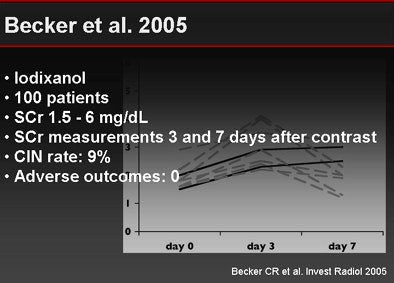 |
| All images courtesy of Dr. U. Joseph Schoepf. |
That same year, the IMPACT trial compared iodixanol with iopamidol head to head in 153 patients with baseline SCr greater than 1.5 mg/dL. The researchers found no significant difference between the agents and no adverse outcomes associated with contrast administration.
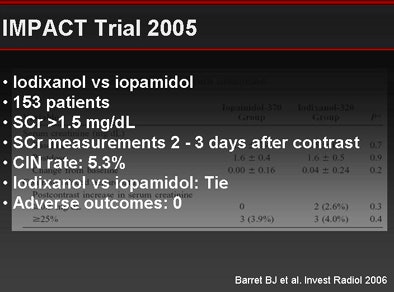 |
In 2007, Mitchell and colleagues from MUSC looked at more than 1,200 patients, including 90 with elevated SCr levels. Although the CIN rate was 6%, there were no adverse outcomes, Schoepf said.
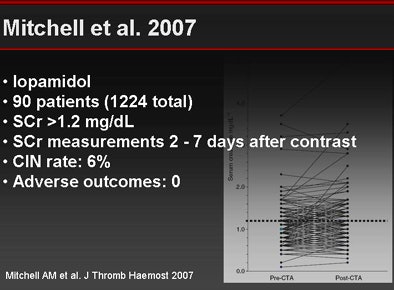 |
The PREDICT trial in 2008 compared iodixanol with iopamidol in 248 diabetic patients with glomerular filtration rates less than 59 mL/min. SCr was measured at baseline and two to three days after contrast administration. Again, there was no dialysis, no patient readmitted, no deaths, and no incidence of acute renal failure.
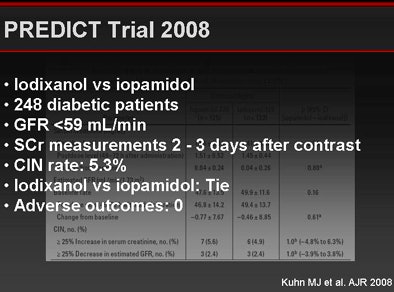 |
A 2008 study in the American Journal of Cardiology took a different approach with its use of renoprotective agents along with iodixanol.
"This one was slightly different because it specifically looked at renoprotective measures, which likely explain the extremely low rate of CIN at 1.75% of individuals," Schoepf said. "Measuring serum creatinine at baseline and at an interval of two to three days after contrast, again, no adverse outcomes were attributable to contrast administration."
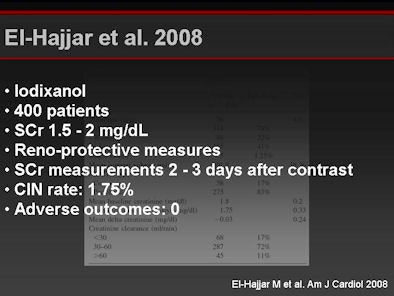 |
The 2008 ACTIVE trial compared iodixanol versus iomeprol in 148 patients with SCr ≥ 1.5 mg/dL and/or creatinine clearance less than 60 mL/min. Overall, 6% of cases had CIN, and iomeprol was associated with fewer cases of CIN. But, again, there were no adverse outcomes.
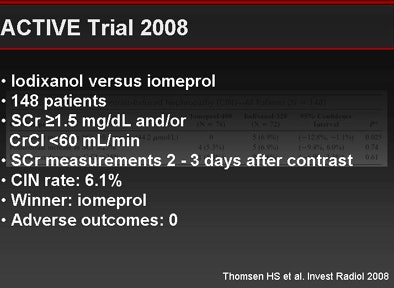 |
Weisbord and colleagues examined 367 at-risk patients at baseline and two to four days after contrast administration. Some adverse events associated with CIN were reported; however, no events were directly attributable to the administration of contrast.
In all, 46 patients (10.9%) were hospitalized and 10 (2.4%) died by 30-day follow-up. "However, contrast-induced acute kidney injury was not associated with these outcomes," Weisbord et al wrote (Clinical Journal of the American Society of Nephrology, September 2008, Vol. 3:5, pp. 1274-1281).
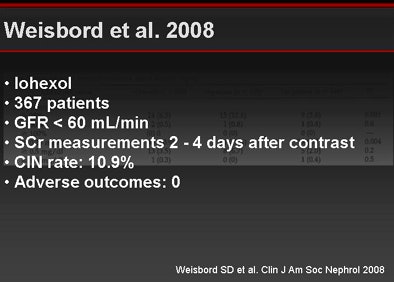 |
Last year, Nguyen and colleagues from Schoepf's institution were looking to more comprehensively assess SCr dynamics by measuring it at one, two, and three days postcontrast. The CIN rate was 17%, but the authors found no adverse events associated with either iodixanol or iopromide. Follow-up at 30 and 90 days again revealed no cases of acute renal failure, dialysis, or death.
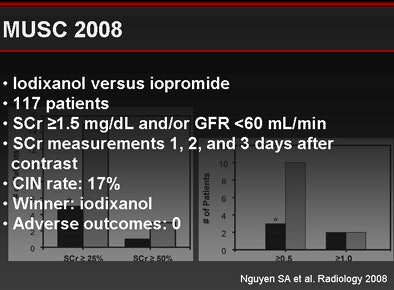 |
In eight trials comprising 1,623 at-risk patients, between 1.75% and 17% of patients developed an increase in SCr that fulfilled the definition of CIN. But there were no patients with adverse outcomes directly attributable to contrast administration.
All of the studies need to be taken with a grain of salt, Schoepf said.
"None of those trials looked at long-term effects of contrast media on kidney function," he said. "Most of the trials ended at the point where the patient had the last serum creatinine drawn, but did not assess a longer-term effect on kidney function. So there is a possibility that patients actually got some nephrons knocked out and kidney function deteriorated, however, without becoming clinically manifest."
Natural fluctuations versus CIN?
Of equal importance, none of the trials compensated for natural fluctuations in serum creatinine, Schoepf said.
Can the CIN metrics be met without the administration of contrast media? Yes, they can, according to an eye-opening 2008 study by Newhouse and colleagues. In some 32,161 at-risk patients who weren't given any contrast media, 27% met the parameters of CIN after blood was drawn and tested for SCr on five consecutive days.
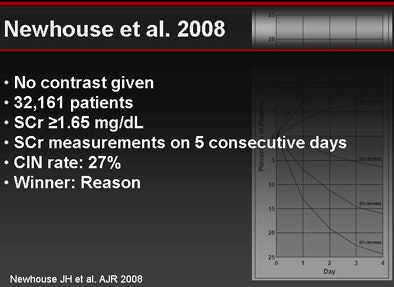 |
"I feel pretty safe in saying that although IV contrast administration is frequently associated with an increase in SCr that fulfills the definition of CIN, clinically manifest adverse outcomes are extremely rare," Schoepf said.
The clinical experience with SCr and CIN leads to some obvious questions, such as:
- Is SCr a useful tool for looking at the safety profile of contrast media?
- Do the results of current trials reflect natural fluctuations in SCr?
- What are the long-term effects of contrast media administration?
- How would a trial be designed to adequately address these questions?
"The real question is what do these results mean in terms of clinical course of our patients, and what happens to renal function months and years after contrast administration?" he said. "I think that's an unanswered question, and we need trials designed to address this question and the bias introduced by natural fluctuations of SCr."
By Eric Barnes
AuntMinnie.com staff writer
July 27, 2009
Related Reading
Acute kidney injury raises risk of long-term adverse outcomes, July 17, 2009
Study confirms link between angio contrast and long-term kidney damage, June 25, 2009
Sodium bicarbonate helps avoid contrast nephropathy, June 5, 2009
Atrial natriuretic peptide protects against contrast nephropathy, March 27, 2009
Iso-osmolar contrast does not lower the nephrotoxicity rate in CKD patients, October 27, 2008
Copyright © 2009 AuntMinnie.com






